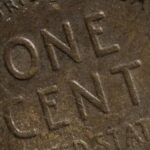The Lincoln Wheat Penny, also known as the “Wheat Cent,” has captivated collectors and history enthusiasts alike. This humble coin, first minted in the early 20th century, carries not only historical significance but also the potential for immense monetary value. Among its rarest versions, some Lincoln Wheat Pennies have been sold for as much as $980,000. Could one of these treasures still be hiding in your pocket change? Let’s dive into the fascinating story of the Lincoln Wheat Penny and its extraordinary value.
A Historical Overview of the Lincoln Wheat Penny
The Lincoln Wheat Penny was first introduced in 1909 to commemorate the 100th anniversary of President Abraham Lincoln’s birth. Designed by sculptor Victor David Brenner, the coin featured a portrait of Lincoln on the obverse and two wheat stalks on the reverse.
This marked a turning point in U.S. coinage, as it was the first time a real historical figure was featured on American currency. The Wheat Penny remained in circulation until 1958, after which it was replaced by the Lincoln Memorial reverse design.
What Makes Some Lincoln Wheat Pennies So Valuable?
While most Lincoln Wheat Pennies are worth just a few cents, certain factors make some versions exceptionally valuable:
- Rare Minting Errors
Errors such as double-die obverses, repunched mint marks, and off-center strikes create unique coins that collectors are eager to own. - Low Mintage Years
Pennies from years with limited production are more scarce and, therefore, more valuable. - Material Anomalies
During World War II, the U.S. Mint temporarily switched to using steel for pennies in 1943 to conserve copper. However, a few copper pennies from that year were accidentally struck, making them some of the rarest coins in existence. - Condition
Coins in mint or uncirculated condition command significantly higher prices than worn or damaged coins.
The $980,000 Lincoln Wheat Penny
One of the most valuable Lincoln Wheat Pennies ever sold was a 1943-S copper penny. During 1943, the U.S. Mint produced pennies from steel due to copper shortages caused by World War II. However, a small number of copper blanks were mistakenly used, creating an extremely rare coin.
In an auction, a 1943-S copper penny in pristine condition fetched a jaw-dropping $980,000. Its rarity, historical significance, and excellent condition contributed to its extraordinary value.
How to Identify Valuable Lincoln Wheat Pennies
If you’re curious about whether you might have a rare Lincoln Wheat Penny, here are some tips to help you identify one:
- Check the Date and Mint Mark
Focus on pennies minted between 1909 and 1958. Look for rare years like 1909-S, 1914-D, and 1943 copper pennies. - Look for Minting Errors
Use a magnifying glass to spot any errors, such as doubled letters or numbers. - Test the Material
For 1943 pennies, check if the coin is made of steel or copper. A simple magnet test can help—copper is not magnetic, while steel is. - Assess the Condition
Coins with minimal wear, sharp details, and original luster are more valuable.
Are Valuable Pennies Still in Circulation?
Yes, rare Lincoln Wheat Pennies might still be hiding in circulation. Over the decades, many people have overlooked these coins in jars of loose change, rolls of pennies, or even old piggy banks. Stories of individuals finding rare pennies in everyday change continue to emerge, inspiring hope among amateur collectors.
How to Start Collecting Lincoln Wheat Pennies
If you’re interested in collecting Lincoln Wheat Pennies, here are some steps to get started:
- Search Your Change
Begin by examining coins in your pocket, jars, or rolls of pennies. Look for Wheat Pennies and older dates. - Visit Coin Shops and Shows
Coin dealers and events are great places to learn more and purchase rare coins. - Invest in Tools
A magnifying glass, coin albums, and a guidebook can help you identify and store valuable coins. - Join Collectors’ Groups
Online forums and local coin clubs can provide valuable insights and tips from experienced collectors.
Why Lincoln Wheat Pennies Matter
The Lincoln Wheat Penny is more than just a piece of currency—it’s a slice of American history. These coins reflect the era in which they were minted, from the celebration of Lincoln’s legacy to the resource constraints of World War II. Their value lies not only in their rarity but also in the stories they tell.
Conclusion: A Treasure in Your Pocket
The Lincoln Wheat Penny serves as a reminder that even the smallest objects can hold great significance. While most Wheat Pennies are worth little more than their face value, rare examples like the 1943-S copper penny have reached extraordinary heights, selling for as much as $980,000.
So, the next time you sift through your change, take a closer look—you might just discover a hidden treasure that could change your life.
Disclaimer: The value of coins can vary depending on rarity, condition, and market demand. Always consult a professional numismatist for accurate evaluations.




